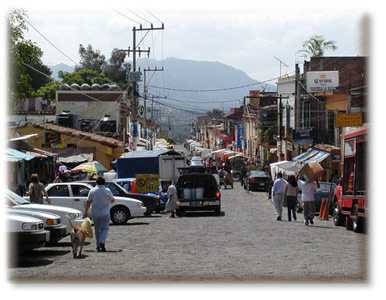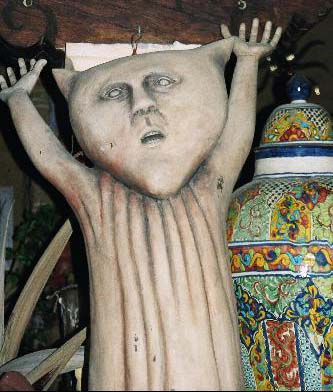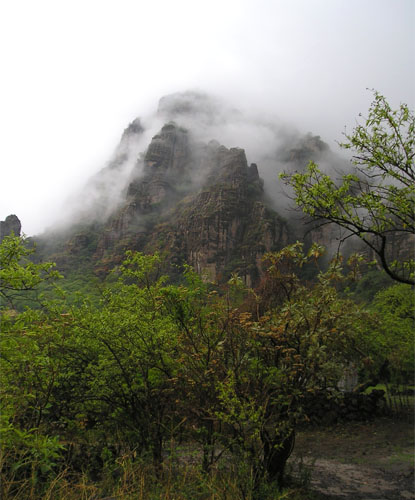TO DO
| Tepoztlán and beyond | ||
Tepoztlán |
|
|
Tepoztlán is a peaceful valley town with cobblestone streets, surrounded by jagged sandstone and volcanic mountains. The name "Tepoztlán" derives from the Nahuatl word "Tepuztli", meaning "copper axe above a hill". Tepoztlán is blessed with spectacular scenery and a very pleasant climate year-round. The main attractions are to stroll around town, enjoy the local restaurants, shop in the market, visit the mission and museum, and take hikes in the surrounding areas. The center of town is bustling on weekends, and the deafening boom of firecrackers is a regular feature. The flora of the Tepoztlán valley are so attractive that it was considered the flower garden of the Aztec emperors. Tepoztlán is also the village where Quetzalcóatl, the Plumed Serpent god of the Aztecs, is said to have been born, and it is known as a mystical center. A steep one-hour hike takes you up to the summit of one of the surrounding hills, where the Tlahuica people built a pyramid (Tepozteco) dedicated to Tepoztécatl, god of fertility and harvest. Hundreds hike it every weekend, and the hike ends with a short stretch of ladder bolted to the stone, at the end of which you will be greeted by begging coatis (tropical raccoons that resemble a cross between a monkey and an aardvark, and like to poke their long snouts into bags, looking for snacks). The church and former convent (Catholic Dominican), which date from the sixteenth century, are in the center of town. There is also a small anthropological museum behind the church and convent, the Museo De Arte Prehispanico Carlos Pellicer, which was established by Carlos' namesake and great-uncle, who lived in Tepoztlan (address: Pablo Gonzalez 2; tel. 777-395-1098). One of the main attractions of Tepoztlán is the marketplace, which has two sections. One is situated on the main plaza, where you can buy fresh groceries and try different traditional dishes. The other takes place on the main road (Avenida Revolución) on Saturdays and Sundays, where you can buy handicrafts. If you are an adventurous eater, you might want to try a salad made of nopal (paddles of the prickly pear cactus), or quesadillas filled with flor de calabaza (squash blossoms) or huitlacoche. Huitlacoche is often translated as "a type of mushroom," or "truffle" to avoid visitors freaking out about what it really is: corn fungus. Whatever you want to call it, it's good -- dark, rich, densely flavored. Tepoztlan is also famous for homemade ice cream (nieves) and sorbet (de agua), and more than 120 original flavors (made only with natural ingredients) are available at Tepoznieves, at Ave. 5 de Mayo #21 (tel. 739-395-3813). These include flavors familiar (vanilla, bubble gum), exotic (tamarind, mango studded with chile piquin), cryptic ("Angel's Kiss", "Symphony of the Sea"), and just plain weird (corn? beet? lettuce???). Printable map of Tepoztlán, showing hotel and party sites
....and beyond Since you are coming all the way to Mexico, why not make a short or long vacation out of it? There are a number of wonderful places depending on how much time you have, and what you would like to see. Here are a few suggestions: Mexico City is one of the largest cities in the world, with too much going on to list. For example, there are more than 150 museums, including the world-famous Museo Nacional de Antropologíca, the Museo Dolores Olmedo, the Frida Kahlo museum, and the Museo Diego Rivera Anahuacalli. Since this is the oldest continuously inhabited ciy in the Western Hemisphere, historical sites abound. For example, Templo Mayor is an archaeological site right in the heart of Mexico city, near the National Palace, which contains many Diego Rivera murals. About 30 miles northeast of Mexico City is the ancient city of Teotihuacán, an exposed, dusty site that is a popular tourist destination. While the fine carvings are absent from this site (for that, see Xochicalco below), it has ruins on a scale to rival the pyramids of Egypt. Cuernavaca, "city of eternal spring", is much larger than Tepoztlán. It is the capital of the state of Morelos and is only 5 miles from Tepoztlán ( a ~20 min drive, due to roads and geography). There are many places to see and explore. Taxco, classified as a national monument, with artisans specializing in silverwork and jewellery, is nearby. Xochicalco, an exceptionaly well-preserved prehispanic ceremonial center that ranks among the richest archaeological sites in all of Mexico, is about 25 miles away.
Migrating monarch butterflies spend the winter in several Mexican preserves, including El Rosario and Sierra Chincua in Michoacán, about four hours by car from Mexico City. In February and March the butterflies perform an elaborate arial mating ritual. Visiting the preserves involves hiking 20 min- an hour at extremely high altitudes -- between 9,000 and 11,000 feet -- so only go if you are in very good physical condition. Several companies offer tours--for example, this one, which leaves the day of the wedding out of Mexico City (you'd have to try to meet them on day 2) for a 10-day bird-and-butterfly extravaganza.
For the hikers and climbers, Copper Canyon is a must-see. Copper Canyon is really a series of canyons which drain the western side of the Sierra Tarahumara. The entire Copper Canyon region comprises almost a third of the state of Chihuahua, which is Mexico's largest state. It's just over two hours from MEX by air.
Weather The weather in the valleys of Morelos, where Tepoztlán is located, is very temperate, and humidity is low. In February the chance of rain is less than 5%; the temperature can reach a minimum of 50 degrees F by night, and a maximum of 80 degrees F by day. Bring a hat for the sun and clothes for subtropical weather: cool at night, warm during the day. Mexico City will be substantially chillier, due to its altitude, and frost is a rare but possible winter occurance in the mountain passes between Mexico City and Tepoztlán. |
||




